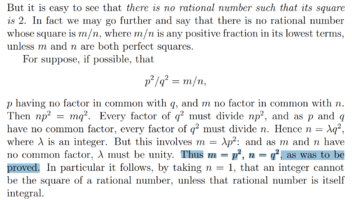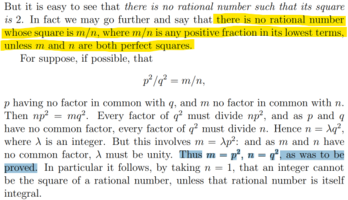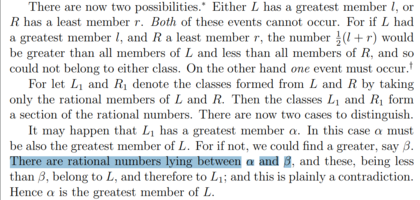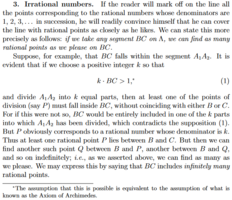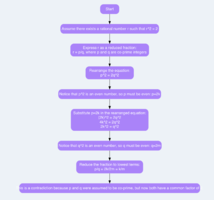MaxMath
Junior Member
- Joined
- Mar 22, 2023
- Messages
- 115
Hi there,
I'm not a mathematician, nor did I study in uni with it as my major. I'm an engineer with an interest in mathematics. Recently I came across this book of Hardy and decided to have a crack at it, partly because I always dreamed of having a taste of real or pure mathematics. This recent random find seems like a good fit; it's a classic and is pretty concise. I don't mind its age at all: quite the opposite.
Having only started off, I found myself in difficulty in understanding the argument, supposed to be a proof, that the square root of 2 is not a rational number. You can find it here. It's on page 22, out of 587 of the e-format, or page 6 in the printed form (shown on the top-right corner) of the page. I've also attached a screenshot of the part I'm talking about (with highlight).
The difficulty I have is --- it appears to me that the proof concludes with the sentence "Thus m=p^2, n=q^2, as was to be proved". This does not seem sufficient to me. This only means, starting from the presupposition (p^2/q^2 = m/n), what we have reached is only getting back to square one. It's not helpful, of course. But this, by itself, does not seem to prove that the presupposition is false, hence proving what is to be proved. This does not lead to any contradiction, as what is normally the desired outcome of this technique of proving theorems.
Can someone be so kind and able to enlighten me on this? Many thanks.
I'm not a mathematician, nor did I study in uni with it as my major. I'm an engineer with an interest in mathematics. Recently I came across this book of Hardy and decided to have a crack at it, partly because I always dreamed of having a taste of real or pure mathematics. This recent random find seems like a good fit; it's a classic and is pretty concise. I don't mind its age at all: quite the opposite.
Having only started off, I found myself in difficulty in understanding the argument, supposed to be a proof, that the square root of 2 is not a rational number. You can find it here. It's on page 22, out of 587 of the e-format, or page 6 in the printed form (shown on the top-right corner) of the page. I've also attached a screenshot of the part I'm talking about (with highlight).
The difficulty I have is --- it appears to me that the proof concludes with the sentence "Thus m=p^2, n=q^2, as was to be proved". This does not seem sufficient to me. This only means, starting from the presupposition (p^2/q^2 = m/n), what we have reached is only getting back to square one. It's not helpful, of course. But this, by itself, does not seem to prove that the presupposition is false, hence proving what is to be proved. This does not lead to any contradiction, as what is normally the desired outcome of this technique of proving theorems.
Can someone be so kind and able to enlighten me on this? Many thanks.

